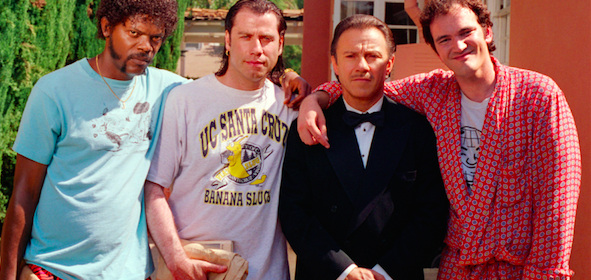In Order to Form a More Perfect Co-op ● by Robert F. Arnove
The dramatic changes Bloomingfoods has undergone since opening its first store in July 1976 are typical of co-ops across the country. For many of the local community members who remember the founding days of their consumer co-op, there is a significant gap between the seat-of-the-pants, let’s all do this together ideal and the real world corporate business–driven imperatives. Melanie Greene, who advises co-ops and other not-for-profit organizations on board development, notes that there is often a “founders disease,” an inability among early leaders to change anything. But a changing national context has forced consumer co-ops to compete with national supermarket chains that also have expanded their local and organic offerings.
Natural food co-ops across the country, according to Bloomingfoods General Manager George Huntington, found themselves in the paradoxical situation of being successful to the point that investors on Wall Street saw locally grown organic produce as a lucrative market in which to invest. Simultaneously, internally driven empire building has led small-scale co-ops to expand and become something very different from what they were. As a case in point, in 1994, when Huntington assumed the position of GM, Bloomingfoods had two stores–now it has five. More than a grocery store, Bloomingfoods has become an integral part of Bloomington’s cultural landscape, partnering with a multitude of community organizations (including The Ryder).
Expansion in relation to an increasing competitive context has created problems for a number of natural food co-ops started during the “new wave” of social movements of the 1960s and 1970s. As early as 1987, Robert Grott (in his article “Why Co-ops Die: An Historical Analysis,” Cooperative Grocer, Issue 9, February-March) noted “A review of this history suggests that the reason for the problems now faced by co-ops . . . lies in the most basic of factors: the very definition of co-ops and their relationship to their environment…. Co-ops are unique in that they have a dual mission – part economic and part social.”
The economic relates to providing “for needs that otherwise would not be met.” The social part relates to the need to operate democratically; “they can provide people with a new measure of control over their lives, and they offer a context for community organizing.” In doing so, co-ops provide a platform for broader social change. If co-ops are to succeed, however, certain environmental conditions need to be present. Unfortunately for Grott (who was general manager of the Hope Neighborhood Co-op in Forest Grove, Oregon between 1975 and 1986), the changed market context in which co-ops had to operate led them to abandon their expectation of having “a significant impact on the economy and society in general. Pursuing a market need is not the same [thing] as being created by one.”
As employees and member-owners seek solutions to the emergence of a more economic than social model of their consumer co-ops, labor unions have found fertile ground for organizing in an otherwise hostile national climate. Since its inception in 1979 (as the result of a merger of the Retail Clerks Union and the Amalgamated Meat Cutters), United Food and Commercial Workers (UFCW) membership has grown to 1.3 million. A promising frontier for unionization is not only employees at commercial giants like Walmart, but at worker-owned and consumer-based co-ops. The first food co-op in the United States to unionize was Outpost Natural Foods in Milwaukee, Wisconsin, in 1979; it is represented by UFCW Local 1443. Since 1979, the UFCW has been involved in organizing at least ten food co-ops across the country.
The changing context and challenges facing Bloomingfoods is best summed up by long-time member Kathleen Mills, who teaches journalism at Bloomington South and who, in the interests of full disclosure, is married to Ryder editor Peter LoPilato. Mills shops at Bloomingfoods regularly:
Co-ops started in the late 1960s and 1970s in America because organic foods and natural foods were not available at the traditional grocery store. It’s incredible to believe, but it was the era when yogurt, quinoa, kale, etc. were simply hard to come by. Co-ops offered those types of products and often were able to get them from local farmers/growers. The other key thing co-ops offered was a discount on these foods because member-owners would band together to buy in bulk. But now, of course, you can get just about everything that is offered at Bloomingfoods at Kroger.
Bloomingfoods Today
Since its incorporation, in 1976, as Bloomington Cooperative Services (BCS), the Co-op has grown to 13,000 member households with 292 employees (138 full time and 154 part time staff). Beginning with its first store in the alley behind Kirkwood, the Co-op has opened branches in the Eastside, Near West, and Elm Heights neighborhoods, as well as in Ivy Tech community college. In 2014, its total assets were $6,898,762; this amount included $4,202.518 in current and long-term liabilities. While gross profits were $8,847,798, total expenses amounted to $9,440,746. Due to the late opening of the Bloomingfoods Elm Heights store, projected sales fell short for the fiscal year ending June 30, 2014. Also, the Kirkwood store has not been profitable for years, with quarterly losses as high as $30,000.
Another budgetary factor is a top-heavy administrative structure, despite efforts to streamline the Co-op’s organization. The current organizational chart is complicated, with approximately forty different types of managers and another 13 administrators one or two steps under the supervision of general manager George Huntington.
In response to recent budgetary deficits, the administration reduced employee hours, and asked a limited number of specialized staff to work overtime. In spring 2014, two national supermarket chains announced their intentions to open stores in Bloomington: Whole Foods in the Eastside Mall, and Lucky’s Market in the former Marsh store on South Walnut. Both are known for promoting local and organic businesses and products.
Unionizing Begins
For at least ten years, there has been unhappiness on the part of some Bloomingfoods employees, primarily with regard to working conditions and how management treats them. More recently, a growing number of member-owners perceive a growing disparity between their notions of what a co-op should be and how their local Co-op operates. The pending Whole Foods and Lucky’s openings have increased dissatisfaction and anxiety among Bloomingfoods employees, with the prospect that higher salaries at the new stores might lure fellow workers to leave Bloomingfoods and that the Co-op itself might not survive the competition.
Together, these conditions ignited the spark to begin unionizing. This summer, a core group of employees invited Local 700 of UFCW, based in Indianapolis, to help them organize a union. The first meeting took place Labor Day Weekend in Bloomington. The union advised employees not to go public immediately, but to collect cards signed by employees indicating their desire to have the National Labor Relations Board hold an election. By mid-October, employee organizers had the signatures of over 30 percent of non-supervisory employees, both part- and full-time.
The Board of Directors and administration of the Co-op responded to the grassroots movement to organize by consulting with Mallor Grodner (MG), a local law firm that the Co-op had on retainer. MG does not specialize in labor law. In preference to a local competitor firm, MG recommended an Indianapolis firm, Barnes and Thornburg (B&T).
The decision to consult with a law firm about the Co-op’s legal and ethical responsibilities regarding unionization seems prudent and reasonable. Less so was the decision to go to a firm whose website reads, “Our passion is to preserve a client’s freedom to manage and to assist our client in helping them remain union free.” The website further states: “We estimate our team has helped manage hundreds of union organizing attempts and/or campaigns, and our clients have obtained favorable results in more than 96% of the campaigns in which we have been involved.”
The Bubble Bursts — The October 7, 2014, Board Meeting
Disclosure that the Board had consulted with B&T ignited a chain reaction of protest from the membership base of the Co-op, many of whom are pro-union. A rally was called by UFCW Local 700 and other local activist groups. Protestors met at the Westside store and then marched to the nearby offices of Bloomingfoods on Gentry.
More people wanted to attend the 6:30 p.m. meeting than the fire code limit of forty set for the Gentry office space allowed. (To attend the meeting, members had to notify the Co-op’s offices of their wish to do so, and only members were to be admitted.)
Bloomington City Clerk Regina Moore at first was blocked from entering the meeting (she was eventually admitted). Moore reminded the Board of three relevant Bloomington Common Council documents: 1) Resolution 97-11 of August 8, 1997, “Supporting Employees’ Right to Organize”; 2) Resolution 07-93, “To Approve Application and Authorize Loan from the Business Investment Incentive Fund” of April 4, 2007, involving a loan of $100,000 to Bloomingfoods for capital improvements to the building at 316 West Sixth Street; and 3) Ordinance 05-08, adopting Chapter 2.28, “City of Bloomington Living Wage Ordinance” of March 24, 2005. (Chapter 2.28 applies to Bloomingfoods because of the 2007 loan.)
Member concerns are briefly summarized as follows: l) the Co-op’s response to unionization efforts; 2) employee statements about why they were organizing; and 3) member dissatisfaction with various aspects of Bloomingfoods, including the quality of products and services; the perceived cultural shift from co-op to corporation; and a need for greater control and oversight of the General Manager (the latter expressed notably in a statement read to the Board by member Gracia Valliant).
Members questioned the decision to consult with the law firm of B&T – why was the firm consulted, who was involved in the decision, the nature and cost of the consultation. Regarding this last point, Summer Vergiels, whose family shops exclusively at Bloomingfoods, spending as much as $13,000 annually, asked under what authority, without member input, the administration used their monies to hire these lawyers. Several members stated that they would leave the Co-op, much as it would pain them to abandon an ideal to which they were committed, if the Co-op fought unionization and resisted better working conditions and a living wage for employees. David Stewart, who served twice on the Board of Directors, stated that he had resigned from the Board after the living wage platform on which he campaigned (which brought him the most votes as a candidate in the Board election) received no support from fellow Board members or the Bloomingfoods administration.
Employee dissatisfaction was voiced by several of the core group of employees leading unionization efforts. Andy Marrs said he had hoped that Bloomingfoods would be a long-term career, but for him as well as many others, there is “the feeling there is no hope for the future.” Wages are just one issue. “Employees aren’t aiming for the stars.” The point, said Marrs, is that “they don’t feel respected . . .. You don’t feel you’re a valued asset. Management doesn’t encourage new ideas; instead, management simply cuts hours.”
As many employees have indicated, there is “a need for more venues to voice concerns.” Marrs loves the Co-op – a common feeling among organizers – and wants to see it revitalized along more democratic lines. Kaisa Goodman of the Eastside store made similar points, expressing the view that unions and co-ops ideally share the same values. She also expressed the concern that if the co-op didn’t return to its founding principles, employees and members would leave for Lucky’s or Whole Foods.
Gracia Valliant read a statement, drafted with eleven other members, regarding Board-management relations. It begins:
We are a group of Bloomingfoods member-owners, who has identified several areas of concern. In the wake of recent unionization efforts, we understand that this is a difficult time in the organization and that there are always multiple sides to any issue. We are not interested in pointing fingers or taking sides. Rather, we are contacting the board in a spirit of cooperation: As member-owners, we want to become better informed and participate more actively in resolving the issues facing the organization….
The statement’s main headings are:
- Lack of transparency with member-owners
- Lack of established mechanisms for hearing the member-owner voices
- Ensure that the position of General Manager is monitored by more than one of the methods stated in this policy
- The non-management employees have neither board representation nor a voice directly with the Board
- Regarding unionization efforts, the neutrality of the Board, administration, middle management, and members is essential
- The timeframe for renewing the contract for the General Manager may be problematic
- In light of the current unionization process, the Staff Treatment and Compensation policy (B6) needs more clarification and specificity
Each concern was followed with specific “Strategic Suggestions” – for example, with regard to point 6 — “Given the current union situation we suggest the renewal of the GM contract be suspended until such time as the operational implications of unionization are better understood.”
At the conclusion of the opening hour of commentary, Board President Tim Clougher read this 9/19/2014 press release:
Bloomingfoods continues to support our staff’s right to seek to organize. We continue to gather information and to educate ourselves regarding the unionization process . . . . . Our attorneys at Mallor Grodner sought specialized assistance from an attorney from the law firm Barnes and Thornburg due to his expertise in labor law and his immediate availability to provide a presentation to supervisory staff so they would not unknowingly commit anything considered an unfair labor practice.
As the press release indicated, unionization of the Co-op was only one of many complex issues on which Bloomingfoods had sought legal counsel over the years. The overall response of the Board to the concerns of employees and member/owners was conciliatory. There was general agreement that the airing of problems was constructive.
The Annual Membership Meeting October 16, 2014 – The Board and Management Make a Peace Offering
The turnout for the 2014 annual meeting at WonderLab Museum was animated and unusually large, involving as many a 300 member-owners – because of the unionization issue. The defining moment was the announcement by Huntington that the Board had voted to sign an agreement of neutrality to allow unionization efforts to go forward. The decision was met by sustained applause and cheers by what appeared to be a largely pro-union audience.
The neutrality decision meant that an election organized by the Co-op and the UFCW, and supervised by a neutral expert from the Federal Mediation and Conciliation Service (FMCS), could be held almost immediately instead of employees needing to turn to the National Relations Board to hold an election after a waiting period of six weeks. Preceding an election, managers and employees agree to a “pledge” involving “No name calling, respect for the mutual roles of management and workers.” A neutrality agreement also designates when and where union representatives will have access to employees. Alternatively, by a majority vote of its seven members, it would allow the Co-op Board of Directors to recognize an employee union.
According to Lynn Duggan, an IU Associate Professor of Labor Studies, by declaring its neutrality, Bloomingfoods had bypassed the cumbersome process of involving the NLRB in an election, and avoided what normally would be a contentious period of mutual recrimination and high employee turnover that harms retail businesses.
According to Huntington, the Bloomingfoods Board and management wanted “to practice the co-op ideal of self-help and embrace co-operative principles of concern for community.” He acknowledged “we’re hearing that we neglected a voice within our own ranks.”
Huntington allowed that in deciding how best to allocate limited resources among these competing goals, the balance had “teetered too much in one direction.” One such imbalance specified by Huntington was the number of part-time (55%) to full-time employees (in line with an average of some 20 other co-ops surveyed that had a part-time to full-time ratio of 40% to 60%.) Full time employees work a minimum of 36 hours per week. Huntington affirmed that Bloomingfoods was a good employer, but conceded that it could be an even better one.
Huntington was in touch with Outpost Natural Foods in Milwaukee in anticipation of the possibility that employees may vote to unionize. Since the mid-1990s, the Outpost co-op has solidified union-management relationships around common interests. Both sides at the bargaining table have used “Interest-Based Problem Solving” to facilitate more harmonious relations. The FMCS website describes the process of conflict resolution as a “win-win” approach. It is briefly described this way: “When everyone understands the interests and concerns that lead a person or group to take a position on an issue, they often find that some of those interests are mutual, that both sides at the table are trying to achieve the same goal, just taking different approaches.”
After the Board President, General Manager, and Treasurer reports, the annual meeting was adjourned. An hour was set aside following the formal meeting for members, employees, and Board members to meet informally at three separate tables to discuss the overarching general themes of staff treatment, Board processes, and unionization.
ARGUMENTS IN FAVOR AND AGAINST UNIONIZATION
Is There a Need for a Union?
Many member-owners and employees question the need for a union in light of Bloomingfoods’ guiding principles. They are 1) open and voluntary membership; 2) democratic member control; 3) member economic participation; 4) autonomy and independence; 5) education, information, and training; 6) cooperation among cooperatives; and 7) concern for community. If these principles are practiced, why have a union? Even if these principles are not practiced, a formal contract between the Co-op and employees, specifying conditions of employment, should still be sufficient to address the same needs that unionization would address.
Employees and members alike readily acknowledge that there are problems that need to be remedied, but resist the notion that to effect the efficient and appropriate operation of their co-op, a third party – a federal agency like the National Labor Relations Board, or a national union, such as UFCW – needs to intervene in their ongoing working dialogue with the Board of Directors and the administrative staff. One generally pro-union member attending the annual meeting wanted to know, for example, how unionization would impact member input into union contracts: what voice would members have in important decisions concerning the direction and running of Bloomingfoods?
Others expressed concern over the failure of the Co-op’s members to be informed about the challenges and contextual forces shaping policy and managerial decisions related to what benefits Bloomingfoods brings to its employees, local vendors, and surrounding communities. With regard to wages and benefits: the Co-op is in conformity with the City of Bloomington Living Wage Ordinance — in 2014, $12.06 per hour. According to the Bloomingfoods 2014 Annual Report and Huntington’s presentation, a full time worker with one year of service earns a rounded-off hourly wage of $11.00. This figure does not take into account an employee’s basic health premium and an employee discount worth a combined value of $2.15. The annual report further notes “Bloomingfoods uses a living wage model calculator that is used by food co-ops across the country that takes regional living expenses into account. The calculator set the living wage in Monroe County at $13.20 per hour.” Bloomingfoods wages compare favorably with those of Outpost Natural Foods, which employs the same calculator. According to Ellen Michel, a previous Co-op administrator, a May 5, 2014, Outpost press release stated that “their goal (was) to bring full-time positions to a livable wage within . . . two years and increase the number of full-time union employees from 38% to 50% over the next several years”
Huntington’s report further noted that the yearly wage for a full-time employee amounts to just under $27,000, with health benefits worth $4,000. Fifty salaried staff earn between $36,000 and $38,000, attractive enough for 55 employees to stay with Bloomingfoods for more than 5 years; this figure includes 9 employees with more than 15 years of service.
Part-time workers earn on average $9.35, compared with the 2014 federal minimum wage of $7.25. The decision to hire a greater percentage of full-time employees will certainly benefit current part-time employees.
In addition to how a well-run Co-op contributes to a strong, sustainable local economy – with profits staying in the community – Bloomingfoods’ five locations are a boon to neighborhoods, such as Elm Heights and the Near West Side, that had been without grocery stores, providing a convenient meeting place to have a meal and purchase local organic foods, including a variety of vegan options. In the “Editor’s Message” column of the August/September 2014 issue of Bloom magazine, Malcolm Abrams wrote, “Ah, that Warm Community Feeling,” and summed up a sense of attachment to the Co-op that is experienced by many, whether or not they have taken a stand on unionization: “Until I came to Bloomington, I never really had a relationship with a grocery store before. But I do with Bloomingfoods. Its west-side store location is near the Bloom office and I’m in and out of there every day, sometimes several times.”
For some, unionization represents a possible threat to this “warm community feeling,” the notion that we’re all in this together. Certainly, critics of unionization point to a long history of conflictive labor management relations that have torn apart industries and communities – placing blame on labor rather than management. Barnes and Thornburg attorney Nathan Baker’s presentations to Bloomingfoods central administrative staff and store managers stoked such fears and common concerns that unionization would undermine merit pay, lead to mediocrity in overall employee performance, and even place management outside protected grievance procedures.
The Election and Beyond
By signing the October 24 neutrality agreement, Bloomingfoods opted to follow the more democratic path of holding an election rather than its Board deciding by a majority vote to accept unionization. Retired FMCS mediator Louis Hilpp supervised the November 10/11 election held at the downtown Marriott Hotel.
The results of the vote were announced the evening of the llth. They indicated a decisive victory for those favoring unionization: 88 “Yes” as against 23 “No” votes.
Representatives from UFCW Local 700 and Bloomington Cooperative Services, Inc. (Bloomingfoods) will be involved in drawing-up a contract spelling out the details of what unionization means. Among the issues to be resolved are the following: will there be a role for a union representative on the Co-op’s Board and, if so, what will it be; will employees have a free or reduced membership fee; will part-time employees have full health benefits? Other questions center on what will relations be like between those employees who join the union and those who do not, as Indiana is a right-to-work state; and what voice will member-owners have in shaping future policy decisions?
[The second installment of The Unionization of Bloomingfoods will be published in the January 9th issue of The Ryder. It will review the reasons for unionization, management’s response and a vision for the future.
Robert F. Arnove is Chancellor’s Professor Emeritus of Education at Indiana University. He writes on education and social change. His latest book is Talent Abounds: Profiles of Master Teachers and Peak Performers (Paradigm Publishers: 2008/2009). The author would like to thank David Edgerton for helpful editorial comments.]
The Ryder ● December 2014














